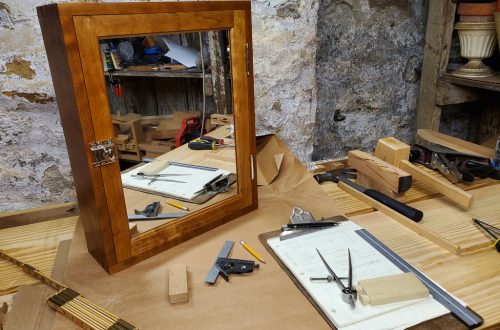Neat Old Companies and Neat Old Tools
 Several years ago, I was in the position of needing a new saw blade for my tablesaw. The existing blade I was using had done a lot of work with some tough white oak for me (including building our front screen door, which was pretty hard on the blade), and it was showing some signs of being dull. I had cleaned it and made sure it was still in alignment, but I was still getting a lot of burning and a pretty poor cut finish. Before just running out to buy a new blade, I asked my wood supplier about sharpening services in the Pittsburgh area. They immediately called out Saw Sales in Gibsonia. I had never heard of the place, but figured it was worth a shot. I grabbed the dull blade and made the trip one Saturday morning.
Several years ago, I was in the position of needing a new saw blade for my tablesaw. The existing blade I was using had done a lot of work with some tough white oak for me (including building our front screen door, which was pretty hard on the blade), and it was showing some signs of being dull. I had cleaned it and made sure it was still in alignment, but I was still getting a lot of burning and a pretty poor cut finish. Before just running out to buy a new blade, I asked my wood supplier about sharpening services in the Pittsburgh area. They immediately called out Saw Sales in Gibsonia. I had never heard of the place, but figured it was worth a shot. I grabbed the dull blade and made the trip one Saturday morning.
As it turns out, this place is awesome. They have a selection of high-quality power tools and accessories, and are also home to an impressive blade sharpening and maintenance operation. They advertise up to 60″ blade capacity. On my first trip out, they gave me a tour of the sharpening and maintenance shop. Their main sharpening rig is an automated CNC system that takes a stack of blades and grinds them according to the programmed specifications entered during the loading process. It was fascinating to watch. Unfortunately, they looked at the blade I brought and said they would not be able to sharpen it. It was a good blade, made by a high-quality manufacturer with a good reputation. It wasn’t designed for resharpening, though, and was instead intended to be just replaced when it went dull. The carbide tips on the teeth weren’t large enough to sustain a sharpening pass and maintain their geometry. They explained all of this and showed me exactly what they were talking about in the process, which was really fascinating. They didn’t have to do any of this, but it helped me understand a lot about saw blade manufacture and maintenance.
When they were finished, I asked the what type of blades were able to be resharpened, and if they had any they would recommend for my application. They brought out a selection of Amana Tool blades, and thus began my use of the Amana combination blade. Giving me every reason to trust their recommendation, it was an easy sell. And, as it turns out, for just a shade more than I paid for the good “disposable” blade I had walked in with, but far less than the other big-name woodworking blades (which, incidentally, ARE able to be resharpened), I walked out with a new Amana Tool blade that has served me quite well.
… until a few weeks ago when I was working on finishing the new blanket chest. Crosscuts were fine, but I started to notice some burning and resistance during ripping operations. I cleaned up the blade, but still had the same issues, so I made a call out to Saw Sales to see what I had to do to get the blade sharpened. I also inquired about hand saw resharpening, as I had my Dziadzia’s (Polish for grandfather) old Disston D-7 that was in need of a sharpening. I used it for crosscuts in raw stock and when I just didn’t want the complications of a power tool, but ever since I brought it down here from my parents’ basement and cleaned it up, it was pretty dull. Saw Sales said just to bring them both out, and they could take care of me. They do the rotary blades themselves, and have someone who does the handsaws for them. So I made a Saturday trip with Jenny a couple of weeks ago to take the blade and handsaw out to drop them off. At the same time, I picked up a new Amana combination blade, so I could start a rotation.
I received a call yesterday that the blade and handsaw were ready for pickup, so I took a swing out to grab them. About $30 later, I had two well-sharpened tools in TruckStor and headed for home.
Although I was happy about the sharpened tablesaw blade, I was incredibly anxious about the handsaw. It was a tool with which I felt a special connection. I also have and regularly use my Dziadzia’s bit brace for boring holes, and have some of his trowels for plaster and mortar work that I’ve used while working on our home. He was a mason by trade (although he also did many other things), and built some awesome things, including the house my mother grew up in and where my parents now live, and the enormous shed we had when we lived in Cooperstown. I have no idea when this saw was purchased. There is a bit of adhesive residue on the back where a price tag may have been at some point. The saw appears to be of the 1940’s era, according to what I’ve been able to find on the web. It was well-used and apparently well-loved in its day. Now that it is sharpened, it’s back to cutting almost like a new tool. I always thought that the previous poor cut quality was just because I wasn’t using it correctly. Now I’m able to make nice, straight, even crosscuts with it, so maybe it wasn’t all my bad technique after all. Someday, I’m going to put it in an electrolysis bath to remove the surface rust, but for the moment, I’m going to continue using it to build things, just as I figure my Dziadzia did when he first bought it and scribed his name on the handle.


So, at the end of this long post, if you are in need of sharpening services, high-quality power tools for wood- or metalworking (this is where I got my SawStop tablesaw a few years ago), or some advice on proper application and care of cutting tools, check out Saw Sales. Meanwhile, I’m going back downstairs to crosscut some more parts for my new workbench with that old Disston D-7.


